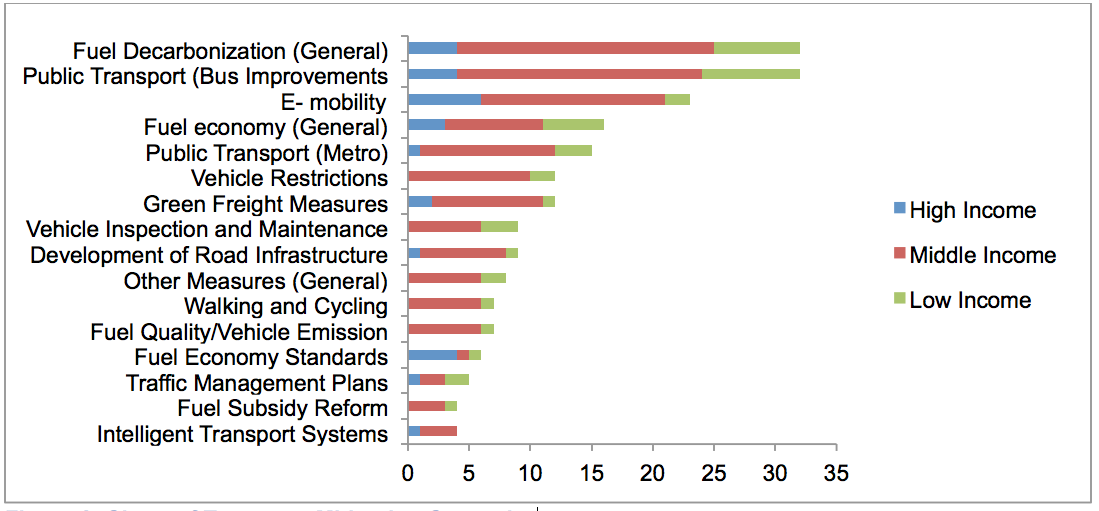SLoCaT Preliminary Analysis of INDCs Sees Potential for Ambitious Action on Climate Change in the Transport Sector
Intended Nationally-Determined Contributions (INDCs) represent a unique opportunity to increase bold mitigation and adaptation measures in transport and other sectors, as for the first time, countries are communicating their intended actions to reduce emissions and increase resilience on sectoral scales in the context of the UNFCCC system.
The SLoCaT Partnership has conducted a preliminary analysis of INDCs in the transport sector, which is intended to inform discussions at the ADP 2-11 session in Bonn, and which is to be developed further before COP21 in December 2015.
Among 120 INDCs submitted as of October 6, 2015, more than three quarters explicitly identify the transport sector as a mitigation source, and more than 60% of INDCs propose transport sector mitigation measures.
Among the 200 transport measures proposed in the INDCs there is a strong bias passenger transport, which is included in 88% of INDCs identifying specific transport modes. Among these, urban transport measures are mentioned in 85% of INDCs, while strategies such as high-speed rail (2%), and walking and cycling (13%) have received relatively less attention (Figure 1). While Freight contributes about 40% of CO2 emissions it is mentioned in less than 20 of the INDCs submitted.

Figure 1: Share of Mitigation Measures by Mode in INDCs
Figure 2 gives a breakdown of specific transport mitigation strategies, with priority varying among countries of different income categories. While e-mobility is prioritized in high-income countries, middle and low-income countries largely rely on public transport improvements (especially bus-based systems) and decarbonizing measures (e.g. biofuels). Further, low and middle-income countries tend to prioritize import restrictions based on vehicle age (e.g. Gabon) along with instruments to improve fleet fuel efficiency (e.g. eco-driving in Cambodia, fuel efficient vehicle incentives in Grenada and Cameroon).

Figure 2: Share of Transport Mitigation Strategies
Regarding mitigation ambition, 13 INDCs (11%) have proposed direct transport sector emission reduction targets, which in some cases exceed the ambition of economy-wide targets (e.g. Burkina Faso and Trinidad and Tobago have set transport reduction targets that are at least twice as intensive as economy-wide emission reduction targets). In addition, a number of countries have established indirect transport emission reduction targets in their INDCs, which target complementary variables such as public transport mode share, renewable energy share, fuel consumption reduction, or fuel efficiency as a means to reach desired emission reductions.
At an economy-wide scale, INDCs are widely expected to collectively fall short of the two-degree Celsius scenario (2DS). Based on existing policies expressed in INDCs, it is not currently likely that the transport sector will attain a 2DS. This is in contrast with a preliminary SLoCaT analysis, which suggests that the transport sector has potential to attain a 2DS; showing that transport emissions in countries with INDCs submitted to date (representing about 80% of 2010 global transport sector emissions) could be largely on track to a 2DS if countries were to intensify implementation of low carbon transport policies.
Climate adaptation has generally received less attention than mitigation in INDCs, being mentioned at an economy-wide scope in 96 of 120 INDCs submitted to date. The transport sector is mentioned in general terms among climate adaptation measures in 13% of INDCs, and 4% of countries identify transport-specific adaptation strategies. Raising the profile of transport adaptation measures in future iterations of INDCs can help to ensure that investments in mitigation measures are well-protected.
In summary, INDCs represent a unique opportunity to increase bold mitigation and adaptation measures in transport and other sectors, as for the first time in history, countries are communicating their intended actions to reduce emissions and increase resilience on sectoral scales in the context of the UNFCCC system. Maximizing national mitigation actions will require optimizing contributions from transport in existing INDCs through mechanisms to increase mitigation ambition in successive evaluation periods.
Preliminary recommendations of the report include the following:
- Ratcheting up transport sector measures and levels of ambition in successive INDC revisions can maximize sectoral leverage to reduce economy-wide emissions.
- Incorporating a balanced approach to transport mitigation in INDC implementation plans, including integrated ‘Avoid,’ ‘Shift,’ and ‘Improve’ strategies, can create multiplier effects, and could increase overall impact
- Quantifying investment requirements for proposed low-carbon transport measures in INDC implementation plans is a key step towards generating needed funding. Strategies to generate additional funding could be complemented by elimination of fossil fuel subsidies, which could then be invested in sustainable transport measures.
- Compiling country-level transport data at more regular intervals could facilitate more effective measurement, reporting and verification (MRV) of transport sector contributions in INDC implementation. Emerging technologies could help to improve the quality, frequency, and affordability of collecting and analyzing transport data.
- INDCs could spur regional dialogues among countries to implement a more comprehensive set of transport measures, based on common demographic trends and development priorities. This could benefit ratcheting up transport mitigation and adaptation measures in INDCs.
- INDCs could be used to stimulate ‘matchmaking’ among national and sub-national entities. INDCs represent ‘demand-side’ commitments that can be complemented by ‘supply-side commitments’ (e.g. low-carbon transport commitments under the Lima-Paris Action Agenda (LPAA)[1].
- The global sustainable transport community could support countries in shaping detailed implementation plans for general mitigation and adaptation strategies proposed in INDCs. Global expertise could be leveraged to help refine and expand country context-sensitive transport specific mitigation and adaptation strategies.
- Parties could further leverage emerging quantitative tools to help optimize transport sector mitigation ambition in INDCs. The Paris Process on Mobility and Climate (PPMC) is creating a set of knowledge products, that can be used to assist national climate planning entities in determining transport sector mitigation potential and ratcheting up transport mitigation targets in successive iterations of INDCs.
For the full preliminary report on INDCs in the transport sector, please click here.
[1]Lima-Paris Action Agenda. http://newsroom.unfccc.int/lpaa/ and www.ppmc-cop21.org/transport commitments.